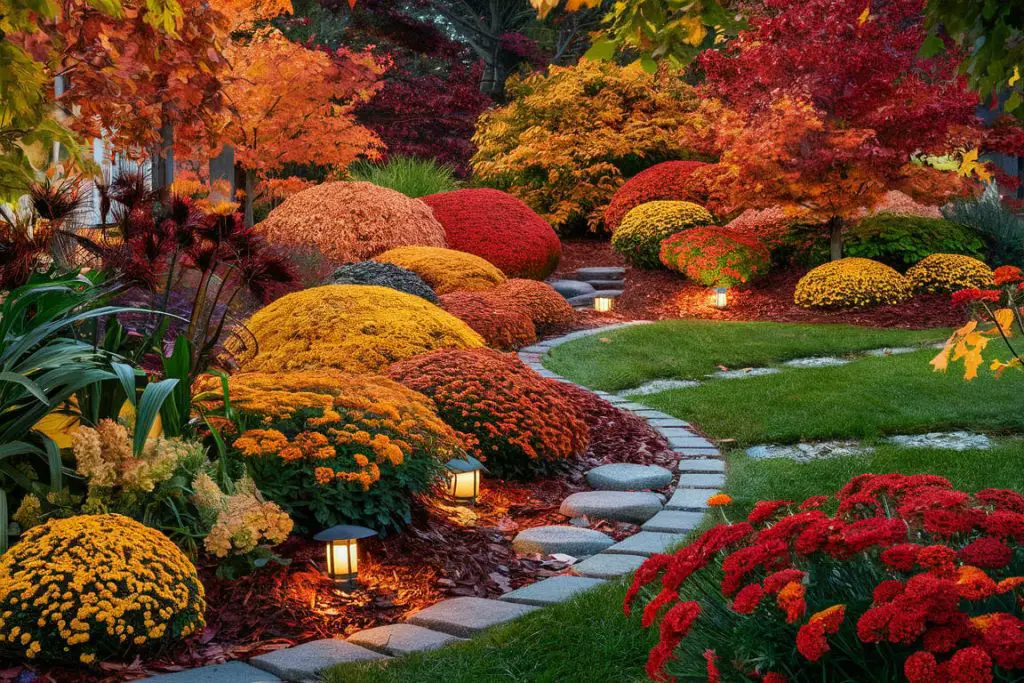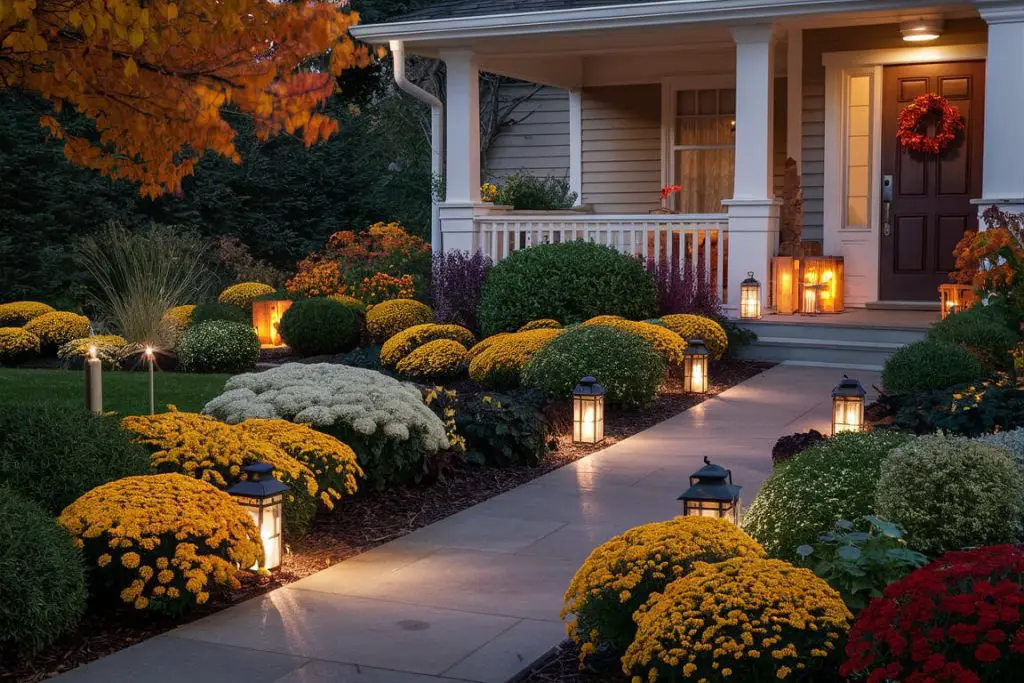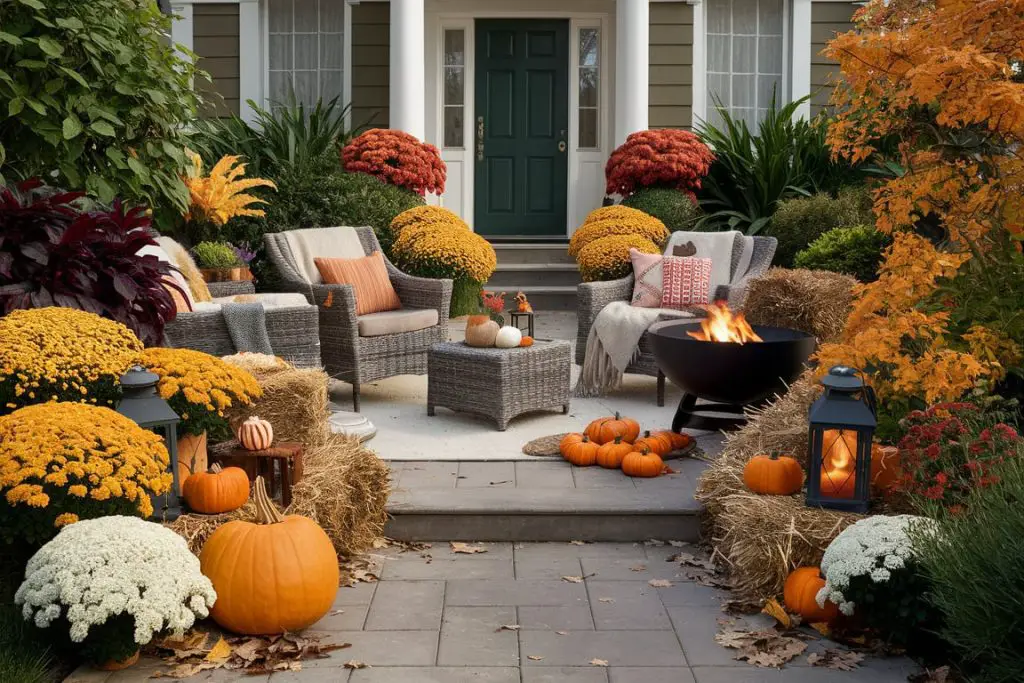Creating Your Fall Front Garden: Cozy and Inviting Ideas for the Season
Fall brings a unique charm to gardens, transforming them into vibrant canvases of warm colors and cozy atmospheres. As the leaves change and temperatures drop, your front garden becomes a welcoming sight for visitors and passersby. Updating your front garden for fall not only enhances curb appeal but also creates a seamless transition between the outdoors and your home’s interior.
A well-designed fall garden captures the essence of the season, evoking feelings of warmth and comfort. From rich hues of gold and crimson to the earthy scents of autumn, your front garden can become a celebration of nature’s seasonal shift. This article will guide you through creating a front garden that embraces the beauty of fall while providing a cozy and inviting space for family and friends to enjoy.
Choosing Fall-Friendly Plants

Selecting the right plants forms the foundation of a stunning fall garden. Hardy varieties that thrive in cooler temperatures and offer visual interest throughout the season are key to creating a vibrant autumn landscape.
Best plants for fall color and longevity
Chrysanthemums stand out as classic fall flowers, offering a burst of color in shades ranging from deep reds to bright yellows. These versatile plants work well in containers or planted directly in garden beds. For long-lasting blooms, consider asters, which provide star-shaped flowers in purples, pinks, and whites.
Ornamental kale and cabbage add texture and color to your garden with their ruffled leaves in shades of purple, pink, and white. These plants tolerate frost well, ensuring your garden remains attractive even as temperatures drop.
Hardy perennials and shrubs
Incorporate sedum varieties like ‘Autumn Joy’ for their clusters of pink flowers that deepen to russet as the season progresses. Black-eyed Susans continue blooming into fall, providing cheerful yellow flowers that attract butterflies.
For shrubs, oakleaf hydrangea offers both beautiful fall foliage and dried flower heads that persist through winter. Burning bush lives up to its name with brilliant red foliage that lights up the garden in autumn.
Adding seasonal annuals for a burst of color
While perennials and shrubs form the backbone of your fall garden, annuals can provide instant color and fill in gaps. Pansies thrive in cooler weather and come in a variety of colors to complement your garden’s palette. Snapdragons also perform well in fall, offering vertical interest with their spikes of colorful blooms.
Consider planting ornamental peppers for an unexpected pop of color. Their small, brightly colored fruits in shades of red, orange, and purple add visual interest and can last well into the colder months.
Incorporating Autumn Decorations

Autumn decorations enhance the seasonal feel of your garden, creating a festive atmosphere that welcomes visitors and passersby alike. These elements can be easily changed or rotated throughout the season to keep your garden looking fresh and exciting.
Using pumpkins, gourds, and corn stalks
Pumpkins and gourds serve as quintessential fall decorations. Arrange them in groups of varying sizes and colors near your entryway or along garden paths. For a natural look, nestle them among your plants or place them on hay bales.
Corn stalks tied to porch pillars or fence posts add height and a rustic touch to your garden. Group them in bundles and accent with colorful ribbon or twine for a polished look.
Adding seasonal wreaths and garlands
Hang a fall wreath on your front door to set the tone for your autumn garden. Choose wreaths made from natural materials like dried leaves, pinecones, and berries for an organic feel. Alternatively, opt for faux wreaths that can withstand outdoor conditions.
Drape garlands along fences, railings, or around mailbox posts. Mix artificial fall leaves with string lights for a warm, inviting glow in the evenings.
Creative use of hay bales and scarecrows
Hay bales serve multiple purposes in fall garden decor. Use them as risers for pumpkin displays, seating areas, or to create levels in your garden beds. Top them with mums or other fall flowers in decorative pots for added color.
A friendly scarecrow adds a whimsical touch to your garden. Place it among tall grasses or corn stalks for a playful, farm-inspired vibe. For a modern twist, create a scarecrow using materials that complement your home’s exterior colors and style.
Enhancing Garden Paths and Borders

Garden paths and borders play a crucial role in guiding visitors through your fall garden. They provide structure and can enhance the overall aesthetic of your outdoor space.
Using mulch and fallen leaves for a natural look
Refresh garden beds and pathways with a layer of dark mulch. This not only tidies up your garden but also provides a rich backdrop for fall colors. Incorporate fallen leaves into your mulch for a natural, seasonal look. Rake them into borders or use them to create protective leaf molds around sensitive plants.
For gravel paths, consider adding a fresh layer of stones in warm tones like amber or rust to complement the fall palette. These colors blend beautifully with autumn foliage and add depth to your garden design.
Planting fall-blooming flowers along pathways
Edge pathways with low-growing, fall-blooming plants to create inviting walkways. Dwarf asters or compact sedums work well for this purpose, providing color without obstructing the path. For a fragrant option, plant sweet alyssum along borders; its tiny white or purple flowers release a honey-like scent.
Consider installing stepping stones among these plantings to create a more defined path. Choose stones in earthy tones or opt for leaf-shaped pavers to enhance the autumn theme.
Tips for maintaining clean and inviting paths
Regular maintenance keeps your garden paths inviting throughout the season. Sweep or blow leaves off paths frequently to prevent them from becoming slippery when wet. Trim back any overhanging plants to keep walkways clear and welcoming.
Edge your paths to maintain crisp lines between walkways and planted areas. This simple task significantly improves the overall appearance of your garden and helps guide foot traffic.
5. Lighting for Fall Evenings

As daylight hours decrease, proper lighting becomes essential for enjoying your fall garden into the evening. Well-planned lighting enhances safety and creates a warm, inviting atmosphere.
Installing garden lights and lanterns
Path lights along walkways ensure safe navigation after dark. Choose fixtures with a warm color temperature to complement the cozy fall ambiance. For a cohesive look, select light fixtures that match your home’s exterior style.
Lanterns placed strategically around seating areas or near garden features provide soft, ambient light. Hang battery-operated lanterns from tree branches or shepherd’s hooks for added visual interest and flexibility.
Using candles and solar lights for a warm glow
Group flameless candles in glass hurricane vases for a safe, flickering light effect. Place these on tables, steps, or interspersed among plantings for a magical evening atmosphere.
Solar-powered stake lights offer an eco-friendly lighting option. Stick them among plants or along borders to create a subtle glow. Look for models with a warm white light to enhance the cozy fall feel.
Ensuring safety with proper lighting placement
Illuminate potential hazards like steps, level changes, or water features to prevent accidents. Use spotlights to highlight beautiful trees or architectural elements of your home, adding depth to your nighttime garden scene.
Consider motion-sensor lights near entryways for added security and convenience. These lights provide bright illumination when needed without constantly consuming energy.
Creating Cozy Seating Areas

Comfortable seating areas invite you and your guests to linger and enjoy the beauty of your fall garden. With the right setup, these spaces can be used well into the cooler months.
Setting up benches and chairs with blankets
Place weather-resistant benches or Adirondack chairs in strategic locations that offer pleasing views of your garden. Group seating to encourage conversation, or position a solo chair for quiet contemplation.
Drape cozy blankets over the backs of chairs or store them in a decorative basket nearby. Opt for blankets in warm autumn hues like deep red, orange, or brown to complement your garden’s color scheme.
Using fire pits and heaters for warmth
A fire pit serves as a focal point for outdoor gatherings and provides warmth on chilly evenings. Choose a style that complements your garden decor, whether it’s a rustic cast iron bowl or a sleek modern design. If you don’t want to permanently have a fire pit in your front yard then you can always use a portable one.
For areas where open flames aren’t practical, consider patio heaters. These provide targeted warmth and can be moved as needed. Look for models with adjustable heat settings to accommodate varying temperatures.
Decorating seating areas with fall-themed cushions and throws
Add comfort and style to your seating areas with outdoor cushions in fall colors and patterns. Look for fabrics featuring autumn leaves, pumpkins, or plaid designs. Ensure cushions are made from weather-resistant materials to withstand outdoor conditions.
Layer decorative throws over chairs or benches for added warmth and texture. Choose throws in chunky knits or soft fleece for maximum coziness. Store these items in a weather-proof container when not in use to keep them clean and dry.
Maintaining Your Fall Garden
Regular maintenance keeps your fall garden looking its best throughout the season. A well-tended garden not only looks more attractive but also ensures the health of your plants as they prepare for winter.
Essential tasks for garden upkeep in fall
Remove spent blooms from flowering plants to encourage continued flowering and maintain a tidy appearance. Rake leaves regularly to prevent them from smothering grass or harboring pests and diseases.
Prune back perennials as they finish blooming, but leave some seed heads for winter interest and to provide food for birds. Clean and store garden tools and containers that won’t be used during winter months.
Preparing plants for colder weather
Apply a layer of mulch around plants to insulate roots from fluctuating temperatures. This is especially important for newly planted specimens or those that are borderline hardy in your zone.
Water plants deeply before the ground freezes to help them withstand winter dryness. Pay special attention to evergreens, which continue to lose moisture through their leaves during winter.
Tips for keeping your garden looking fresh and tidy
Remove fallen fruit or vegetables from the garden to prevent attracting pests or diseases. Keep bird feeders filled to encourage feathered visitors, adding life and movement to your winter garden.
Regularly check decorative elements like pumpkins or gourds for signs of decay and replace as needed. Refresh mulch in high-traffic areas to maintain a neat appearance throughout the season.
Final Thoughts of Creating a Cozy Fall Front Yard
A well-maintained fall garden offers numerous benefits, from enhancing your home’s curb appeal to providing a cozy outdoor retreat. By carefully selecting plants, incorporating seasonal decorations, and creating inviting spaces, you can transform your front garden into a celebration of autumn’s beauty.
Your fall garden serves as an extension of your home, welcoming visitors and providing a space for relaxation and enjoyment. As you implement these ideas, remember that your garden should reflect your personal style and preferences. Experiment with different plant combinations, decorative elements, and seating arrangements to create a space that feels uniquely yours.
Embrace the changing seasons and allow your garden to evolve with them. A thoughtfully designed fall garden not only enhances the beauty of your home but also provides a connection to nature during this transitional time of year. So bundle up, grab a warm drink, and step outside to enjoy the crisp air and vibrant colors of your cozy fall front garden.
